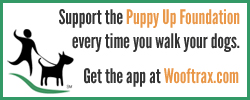
By Bob Bamberg
Perhaps gone are the days when you and your dog played flying disc or other forms of fetch all day or went for long walks along the beach or in the woods. Ten years into your B-F-F-ship, you’re just as robust as ever, but Boomer has slowed down a lot.
There are a number of things that could contribute to a dog’s limited mobility as it ages. Certainly arthritis ranks high, as does obesity. Over half of the nation’s dogs are overweight or obese. Congenital conditions such as hip or elbow dysplasia and infections such as Lyme disease are factors, too.
Even a game of fetch can result in seemingly minor injuries that limit mobility. While chasing a thrown object, a dog can slip, bang into something, or turn too suddenly, resulting in tears to the cruciate ligament.
The natural process of aging sees muscles and organs not firing on all cylinders; the heart being foremost. Older dogs are subject to valve and heart muscle issues, a symptom of which is getting winded after mild exertion. Such dogs should be seen by a veterinarian.
There are activities that you and your dog can engage in that will help maximize fitness. Inside, you can join your dog in moving throughout the house, especially if you hide morsels of favorite treats to discover along the way, or utilize a treat ball that dispenses treats as it is pushed around.
In addition to exercising muscles and joints, such activities can also be mentally stimulating. Slowly going up and down stairs is good exercise, if your dog is up to it. If not, a ramp will provide similar benefits.
Your older dog needn’t give up daily walks, but you may have to shorten them and limit their number. And choose surfaces that are easy to walk on, avoiding sand and off-trail walks in the woods.
Swimming is an activity that exercises muscles without putting stress on joints. Some veterinary and canine spa facilities have pools for injury therapy and may offer open swim time.
A quality diet served in proper proportions not only helps keep your dog’s weight within normal limits, it also supports various bodily parts and systems. There are a number of quality foods on the market and, contrary to what many believe, there is no one best dog food.
There are no regulatory profiles for pet foods labeled “senior,” “mature” or other designations for older dogs. The AAFCO Nutrition Statement (usually located near the Guaranteed Analysis) will indicate the food is formulated to meet the nutritional levels established by the AAFCO Dog (or cat) Food Nutrient Profiles for maintenance or all life stages.
Supplements may be beneficial to your older dog, supporting cognitive function, joints, skin and coat, and other systems and organs. For example, fish oil is an anti-inflammatory that also supports heart health, joints and skin and coat.
As your dog approaches his or her senior years, it’s important to meet with your veterinarian to discuss a game plan. Dogs are living longer and geriatric care protocols are evolving. A veterinarian can make diet, supplement and exercise recommendations that are specific to your dog.
Bob Bamberg has been in the pet supply industry and writing about pets, livestock and wildlife for three decades. He can be reached at petsap@comcast.net.








